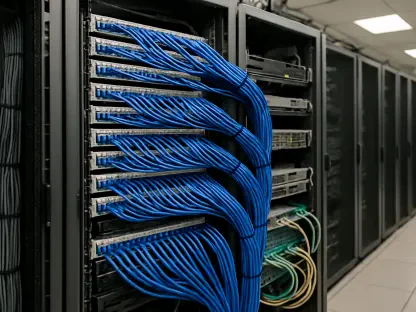In an era where digital infrastructure can make or break a business, a staggering statistic sets the stage: data centers worldwide consume nearly 1% of global electricity, with cloud computing driving much of that demand. Enter Microsoft’s latest innovation, the Cobalt 200, an Arm-based custom CPU designed to revolutionize cloud efficiency. Unveiled as a successor to its predecessor, this chip promises to tackle soaring energy costs and the intense requirements of AI workloads, offering a glimpse into a future where performance and sustainability coexist seamlessly.
The Urgent Need for Cloud Efficiency
The stakes in cloud computing have never been higher for enterprises. With businesses increasingly reliant on digital operations, the pressure to manage costs while meeting performance demands is relentless. AI workloads, in particular, have escalated expenses, pushing hyperscalers to seek alternatives to traditional architectures that often fall short in efficiency.
Beyond financial concerns, environmental impact looms large. Data centers are under scrutiny for their carbon footprints, with regulators and stakeholders demanding greener solutions. Microsoft’s focus on custom silicon like the Cobalt 200 reflects a broader industry pivot toward energy-efficient designs that address these dual challenges of cost and sustainability.
Why Cloud Computing Dominates Enterprise Strategy
Cloud infrastructure is no longer just a tool—it’s the backbone of modern business. From real-time analytics to global collaboration, companies depend on scalable, reliable systems to stay competitive. Yet, the rising complexity of workloads, coupled with supply chain constraints for specialized hardware like GPUs, has created bottlenecks that threaten operational agility.
Hyperscalers like Microsoft, AWS, and Google are racing to innovate, moving away from one-size-fits-all x86 architectures. Custom chips tailored for specific tasks offer a way to optimize both performance and power usage, a critical shift as enterprises balance growth with shrinking budgets and environmental goals.
Inside the Cobalt 200: A Technical Breakthrough
At the heart of Microsoft’s latest offering lie several impressive upgrades. The Cobalt 200 features 132 active cores, a step up from the 128 in its earlier version, paired with a robust cache structure of 3MB L2 per core and 192MB L3 system cache. These enhancements equip the chip to handle the heaviest enterprise tasks with ease.
Manufactured using a cutting-edge 3nm process, compared to the 5nm of its predecessor, this CPU achieves a claimed 50% performance boost while slashing energy consumption. Already integrated into services like Microsoft Teams and Defender, the chip is poised to power select Azure VM families starting early next year, expanding its reach across data centers globally.
The significance of these advancements cannot be overstated. By packing more power into a smaller footprint, the Cobalt 200 positions Microsoft as a formidable player against competitors like AWS’s Graviton and Google’s Axion, signaling a fierce battle in the Arm-based cloud arena.
Industry Voices Weigh In on the Impact
Analysts are quick to highlight the transformative potential of this technology. Stephen Sopko from HyperFRAME Research predicts that for large-scale deployments, such as a 1,000-instance cluster, the efficiency gains could reduce total cost of ownership by 30-40%. This level of savings could redefine how businesses allocate resources in their cloud strategies.
Matt Kimball of Moor Strategy and Insights adds another layer of perspective, stating, “This isn’t just about speed—it’s about smarter energy use, especially for AI and data-intensive tasks.” Such throughput-per-watt improvements suggest that enterprises can achieve more with less, a compelling proposition in a resource-constrained market.
These expert insights point to a larger trend: hyperscalers are no longer just providing infrastructure but are shaping how businesses approach scalability and sustainability through bespoke solutions. The Cobalt 200 stands as a testament to this evolving paradigm.
Strategies for Enterprises to Maximize Benefits
For companies looking to harness this innovation, preparation is key. A critical first step involves assessing which workloads—such as AI inferencing or large-scale data analytics—stand to gain the most from the chip’s enhanced capabilities. Identifying these use cases ensures a targeted approach to adoption.
Planning for integration also demands attention. With availability in Azure VM families on the horizon for early next year, IT teams should evaluate current cloud architectures to prioritize high-impact transitions. This proactive stance can minimize disruptions while maximizing early benefits.
Finally, the projected cost savings offer a strategic opportunity. Redirecting the 30-40% reduction in total cost of ownership toward innovation or expansion can provide a competitive edge. By aligning with the strengths of this new CPU, businesses can position themselves at the forefront of a cloud-first landscape.
Reflecting on a Milestone in Cloud Innovation
Looking back, Microsoft’s unveiling of the Cobalt 200 marked a pivotal moment in the quest for optimized cloud computing. The chip’s superior core count, advanced manufacturing, and focus on energy efficiency delivered substantial gains for enterprises wrestling with modern infrastructure demands. It stood as a bold response to industry-wide challenges.
As the dust settled, the path forward became clear: businesses needed to act swiftly to evaluate their workloads and prepare for integration. Exploring partnerships with hyperscalers to test and deploy such technologies offered a practical next step. The journey toward sustainable, high-performance cloud solutions gained momentum with this release, setting a benchmark for what is possible in balancing power and responsibility.









